ADENIUM CULTIVATION
Adeniums are basically long lived, succulent perennials from tropical regions. They are not, generally, desert plants. More over, the cultivars and even species in cultivation today represent a "domesticated" selection- only clones that could take the wetter conditions under cultivation survived with the result that remaining plants are even less happy with arid conditions than wild populations.Basic Concepts:
Adeniums are basically long lived, succulent perennials from tropical regions. They are not, generally, desert plants. More over, the cultivars and even species in cultivation today represent a "domesticated" selection- only clones that could take the wetter conditions under cultivation survived with the result that remaining plants are even less happy with arid conditions than wild populations.
For a group as tough as Adeniums, for all practical purposes, the only way to kill established plants is to provide a combination of wet and cold or to over water them in a sticky, poorly draining medium. Once night temperatures go below 10 deg C, plants need to be kept quite dry or they will rot.
Media:
Adeniums typically need a very well aerated yet moisture retentive media for the best growth. However, media selection must be made in conjunction with existing watering practices or the latter must be modified to suit the media selected. For example, if your system is to water frequently, use a media with low water retention.
Some examples of successful media include:
THAILAND MEDIA: a very non western model which works for them. Media is a mix of clay (often quite sticky), pig manure, coconut husk chunks, semi composted Samanea saman (Rain tree) leaves and some coco peat as well as rice husk charcoal.
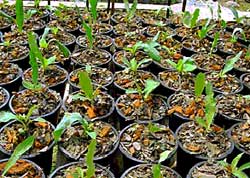 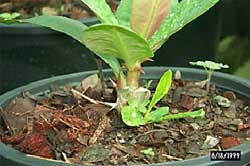 |
| These close-up pictures of Euphorbia hybrids in Thailand illustrate the kind of media being used by them; Adeniums get the same or similar media, depending on the grower. |
What makes this work are the coco chunks: this most peculiar material holds water like a sponge yet allows enormous amounts of aeration. The leaves provide slow release nutrients, the clay provides some more as well acts like a buffer by locking and slowly releasing nutrients.
TAIWAN MEDIA: totally different system, possibly because of the difficulties in getting coco chunks. Their media is 80% stone chips with the balance being tree fern fiber and a little coco peat.
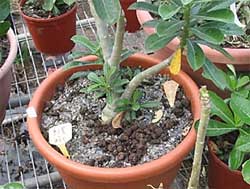 |
Adenium growing in a media consisting largely of stone chips in Taiwan. A little fern fiber and coco coir is added to retain moisture. |
This media is used by almost all growers (the pots are really heavy!) with very good results. (Recent communication on the Adenium group seems to indicate that this may not be quite true and that an alternate media containing coarse sand, rice husk charcoal and rock wool (?) seems to be gaining favor but we will only know the details after my next trip)
OUR MEDIA: For a long time, we used composted cattle manure as the base along with peanut husk and vermiculite: this gave us good results but was not consistent. We have now changed completely to a new media: we start with low nutrient media to enable us to control the amount of fertilizer our plants are getting. The components are divided into two types: moisture retaining and non-retaining. We use roughly equal part of both types to get a balance in the moisture retention. We sieve away fine material and keep particle size of all components as close to each other as possible to get good aeration. Within these parameters we change the mix depending on the plant size (seedling, mature or specimen etc), plant use (local or export, grown to provide propagation material or sale etc) and season (more moisture retentive media if potting in the dry season, less in winter).
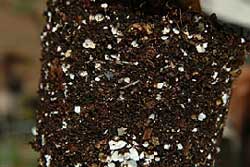 |
This picture shows our media in use for Adeniums: in this case some old seedlings were transplanted into fresh media: white new roots can be seen on knocking out the root ball after only 48hours of the repotting! |
| MOISTURE RETAINING MATERIALS Coco peat: 3 parts Vermiculite: 1 part Cattle manure: 1 part |
MOISTURE NON-RETAINING MATERIALS Styrofoam (Thermocole) (ground): 2 parts Peanut shells (ground): 2 parts Stone chips: 1 part |
We realized just how important this balance is recently: I noticed more than normal levels of mortality in recently repotted grafts recently- at first I thought it was contaminated media and used a systemic fungicide, with little effect. After a couple of weeks I noticed that the whole lot had been repotted using a large batch of media that was mixed without ground Styrofoam (Thermocole). We immediately segregated the lot so that they could be watered less than the regular plants and increased spacing between plants to increase transpiration. Hot conditions also helped and once the roots had filled the media we had no further problems.
Media mix, in themselves, mean very little. They must be tied to environmental and cultural conditions to give the best results. For further details of media components, formulation and use, see my article POTTING MEDIA BASICS at www.hoscoindia.com .
Containers:
With a well designed, aerated media and a little control on watering, plastic pots work as well or better than porous clay.
Container shape tends to be more important in determining growth: we find that early growth is better in deeper pots compared to half pots or bowls. More mature plants are OK with shallow pots. I suspect the reason for this is the tap root in relatively young plants: a lot of active roots tend to sprout from the base of this tap root. With age, axillary roots from the caudex proliferate and, especially if the plant is lifted during every repotting, the root distribution becomes shallower, allowing young active roots to exploit a shallower soil profile. Also, the absolute depth in large shallow bowls is still substantial compared to the depth of a 10-15 cm half pot.
Drainage holes must be plenty and unblocked as water logging is fatal.
For more information on growing containers visit Horticultiral Supplies Co
Watering:
The answer to "How much" is easy: when the plant is growing, always enough to wet the soil thoroughly with some coming out of the bottom of the pot. In winter, with the plant not in growth or even dormant, it may be necessary to water a little each time, just to keep the media from going bone dry.
The important decision is when or how often to water: this depends on a number of factors: season (whether the plant is actively growing), environment, media, etc.
Growth: when actively growing, Adeniums can use a lot of water- more than most people realize. Too little water at this time will check growth severely. Dormant Adeniums must be kept only very slightly moist. Some, like A. arabicum can be kept totally dry when dormant.
Environment: hot, dry conditions mean at least daily watering. Under cool winter conditions, even with some plant growth, watering may be every 7-10 days.
Media: in a media like Taiwan's, with very little water retention, regular watering is both necessary and desirable. More water retentive media like ours will need less frequent watering.
Container size: Large specimen plants require less frequent water, partly because big pots don't dry quickly and partly because large plants are more resistant to dry conditions.
Growth stage: young plants growing rapidly require frequent watering. Plants that are a few years old do not grow very rapidly and need less frequent watering.
Growth control: gradual holding of water and nutrients will give a toughened plant with hard caudex that will take winter better and ship safely.
Other factors: newly transplanted material requires especially careful watering till roots are well under way and growth starts. Under cool conditions do not water until shoot growth is seen. Conversely, pot bound plants will require frequent watering, to a certain extent because the caudex will have more or less squeezed all the media in the pot.
How to water is another aspect: Normally and when possible, water the media in the pot directly rather wet the foliage and flowers. This is particularly important when conditions are very humid, foliage is very thick or a lot of flowers are open. That said, occasional overhead drenching in the morning are great to clean out the foliage of dirt and dust and to refresh and rejuvenate plants on hot, dry days.
Enviroment:
Adeniums grow best under warm, moist and sunny conditions.
TEMPERATURE:
There doesn't seem to be a problem at all with high temperature, especially with a concurrent increase in humidity. We typically reach 42 deg C in summer and have kept Adeniums even higher when under low poly without any problems.
The flowers will, however, age faster under hot conditions. Reds especially tend to fade rapidly. When combined with low humidity, petal edges may scorch.(we now select for fading and scorch resistant Reds). On the lower side, we get down to an absolute minimum of about 6 deg C at night in winter but days are still warm. For cultivation in temperate countries, a safe minimum should be 10 deg C.
HUMIDITY: Adeniums love high humidity and are at their best during the rains (but protected by plastic cover). They can, however, take low humidity easily and also a certain amount of arid conditions. We have noticed, however, that the variation in flower color etc between clones reduces markedly under dry conditions. Thus we noticed much more variation when plants were grown in coastal Bombay as compared to our present inland location. Humidity is relatively easy to increase so we don't have so much of a problem now as all plants are grown under plastic.
SUNLIGHT: Under most conditions, especially with adequate humidity, Adeniums will take and appreciate as much sun as possible. However, under our very hot summers with low humidity, they prefer shading compound on the plastic-the plastic and the compound probably cut off 25-30% of the intense sun. Under full, hot sun the exposed caudex will sometimes burn if the leaf canopy does not shade it.
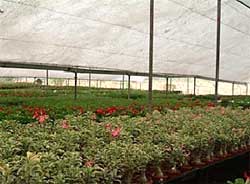 |
The plastic above our Adeniums is sprayed with lime during the summer to reduce both, light intensity and heat. The rains slowly wash away the lime, allowing maximum light in during the cloudy monsoon period. |
Also some of the really white variegated Adeniums will scorch under very high light levels and need a little extra shade. To flower well, most Adenium cultivars need at least 4-5 hours of direct sun daily, with bright light during the rest of the day. Such conditions are easily provided in a balcony and outside or just inside an East, West or South facing window. Given less light most will still flower but less frequently and with fewer flowers.
RAIN: A little rain is fine and indeed invigorating for Adeniums. In Bangkok, which gets frequent afternoon showers, Adeniums are grown in the open all year with good results.
In Taiwan and with us, however, the monsoon season with continuous rain for days on end will play havoc with Adeniums and leaf and stem as well as caudex rot is frequent. We therefore now grow almost all plants under simple plastic structures which mainly protect plants against the rains.
Nutrition:
The secret to Adenium nutrition is little & often. Because the plant, given ideal conditions, can grow surprisingly fast, it can utilize a lot of nitrogen and other nutrients. On the other hand, excessively fast growth is soft and susceptible to rot as well as aesthetically unappealing.
My policy with Adenium nutrition is to follow the plant's lead: maintain a low but constant level of basal nutrition and feed extra when the plant is going into a growth spurt. How much and what we give in this extra feed depends on many factors such as media, season as well as our aims regarding that plant: a variety that we are bulking up on and rapidly propagating will get much higher levels of feed than one being grown as a flowering pot plant. Similarly, heavily bearing mother plants require high levels of specific nutrients to give the best seeds.
Fertilizer Suggestions:
The following is our way of feeding our Adeniums and is reasonably successful. No doubt it can be improved upon and we ourselves keep trying to get better results all the time. Also note that it works with our media, under our conditions and with our systems and would need to be modified for other situations. A more detailed article on plant nutrition FERTILIZING POT PLANTS can be viewed at www.hoscoindia.com. For details on nutritional problems, see NUTRITIONAL PROBLEMS.
Organic Slow Release:
Since we start with a low nutrient media and do not add a nutrient charge to it, we need a source of slow release fertilizer. The various coated materials like Osmocote etc are either not available here or are too costly. What we use, with surprisingly good results is pelleted chicken manure. A table spoonful or two as a topdressing perks up the plants no end. A small amount is added to the media as well while mixing.
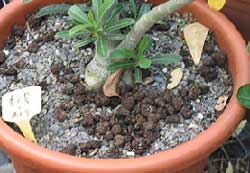 |
Pelleted chicken manure is commonly used as a top dressing in Taiwan. The growers assured me that no chemical (inorganic) fertilizer is used at all. |
I saw this being used in Taiwan where it's used exclusively by some of the best growers and their media is almost all stone chips.
Chemical Fertilizers:
We now use a complete liquid fertilizer containing all Macronutrients (Nitrogen, Phosphorus, Potassium, Calcium, Magnesium and Sulphur) as well as all Micronutrients (Iron, Manganese, Copper, Zinc, Boron and Molybdenum). This is used at alternate watering at an EC of 1.5mS/cm and is giving us better results than our old system of using only Calcium and Potassium nitrate in the liquid feed. The exact ratios of the nutrients can be varied and we are juggling them to find the best combinations for our conditions. This would also depend on the growth stage and season.
Pruning:
One of the least common cultural practices for Adeniums must be pruning- most growers will never prune. There is some merit to this when growing species and under conditions that limit growth. Under good conditions however, Adeniums will make progressively longer stems with poor flowering.
Adeniums respond to pruning in the following situations:
Pinching Seedlings: Seedling plants are often pinched to get a well branched plant. This must be done during periods of vigorous growth or only one bud will sprout, taking you back to where you started.
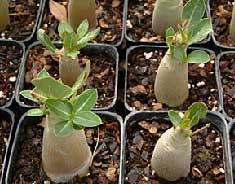 |
Adenium arabicum seedlings with terminal growth pinched: this was a trial to see what kind of form this type of pruning gives. These seedlings show multiple sprouts about 45 days after the snip. |
Done at the correct time this is a useful technique but can sometimes result in a large number of tiny axillary sprouts which look unnatural.
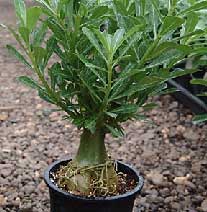 |
A case where pruning has gone wrong: after the main stem was cut back the plant sprouted over 10 stems, giving, in my opinion, an unacceptable form for an Adenium. |
Rejuvenation: Old plants with overly long, leafless stems can be pruned back in spring to improve and invigorate the plant and promote new growth which will bear flowers. Ideally combine this with repotting into fresh media.
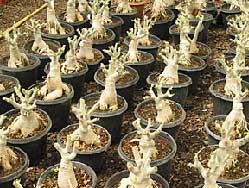 |
Our specimen plant material is pruned hard every two years. |
Flower initiation: One of the surest ways to induce bloom in grafted Adeniums is to prune them hard: new growth will bear flowers, especially under cool short day conditions.
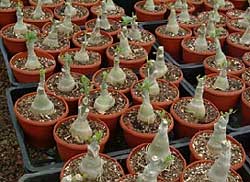 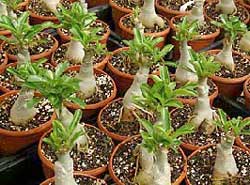 |
| Grafted plants pruned back to one inch stubs (left). These sprout vigorously after about 45 days under good conditions. In summer the flowering may be delayed and sparse but under cool conditions the stems will all bear flowers before long. |
With experience it is possible to time the pruning to get massive bloom at a particular time, for example flower shows. The Thai's are experts at this and superb plants in spectacular bloom can be seen at their shows in Dec and Feb.
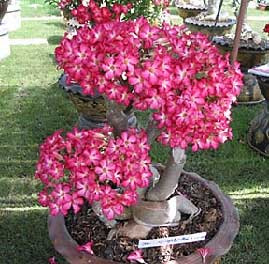 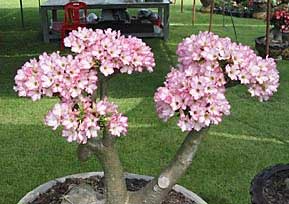 |
| Two specimen plants at the December show in Bangkok: pruned hard about three months earlier, they are in spectacular bloom in time for the show. |
Root Pruning: With time Adeniums develop a very massive root system with thickened secondary roots. When transplanting, it is often necessary to cut off these roots at their junction with the caudex to make it easier to get the plant into the new container and to give some space to get at least a reasonable amount of media into the pots.
Disease control: Very thick growth is best thinned before the monsoon- water & moisture collection can lead to rot. Despite all precautions, Adeniums will sometimes rot. If this happens to one of the smaller stems, it is often best to prune off the diseased portions- I generally like to prune to the nearest main stem or trunk so no stub is left.
This is not as straight forward as it seems. Check the cut to make sure its white: any black discoloration means the pathogen has reached the cut area and you need to go down still further.
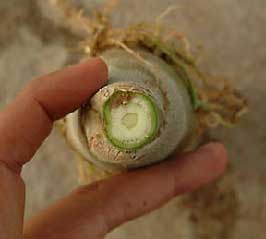 |
Cut end of an Adenium plant showing just a small discolored sector at 11 o'clock but this will spread unless the stem is re-cut at a lower level where there is no sign of disease and the stem section is clean and white. |
The knife or other cutting tool is also contaminated so make sure it is sterilized to prevent the second cut from getting infected.
Healthy plants that develop stem rot will often heal themselves: the infected portion can be seen as a yellow or blackish zone with a distinct border from where healthy tissue starts. Gently try and snap off the dead portion- if an abscission zone has been formed already, it will come off, leaving a clean white healthy stub at the other end. If not, try again after a few days. If the diseased end is mushy, the skin is best pulled off to allow the inner portion to dry rapidly, after which it should come off with little effort. (see Adenium Problems for details and photographs)
Pest Control and Annual Pruning:
For plants that are already tall enough, it is a good idea to prune annually or at least every two years. A certain amount of thinning to remove weak, damaged or inward growing stems can be done at the same time. Apart from the advantage of producing fresh new growth that will flower, this procedure will remove two of the most persistent pests of Adeniums: spider mites and mealy bugs, both of which are concentrated at the growing end amongst the leaves.
Repotting:
Adeniums respond well to annual or biannual repotting. At the time of repotting old media may be completely washed off (essential if the media has degraded and become soggy) or it may be retained and fresh media used to fill the rest of the pot.
Mature specimen plants can be planted into decorative pots- I have seen some beautiful plants in pots carved out of solid marble.
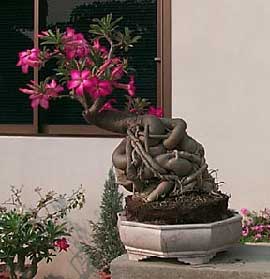 |
A specimen Adenium in a decorative pot carved out of solid marble at a Bangkok collector's residence. Such pots cost about US$300 to 600, depending on the size and quality. The soil mass above the pot will be slowly washed away, revealing more of the roots. |
Often the root mass will have developed so much that it is impossible to get it into the new pot. In such cases it does no harm to prune some of the roots off, especially those with a narrow neck near the main caudex. Plants can also be stem pruned and thinned at the time of repotting.
Spring is the best time for repotting- this is when fresh growth is just beginning and rapid root growth will support vigorous shoot growth. Sometimes this explosive shoot growth (probably in part due to micronutrient deficiencies) will lead to many small shoots at each stem end. It is best to remove all except 2-3 shoots from each main branch to ensure healthy growth.
A drench with a systemic fungicide like Ridomil (active ingredient: Metalaxyl) or Aliette (active ingredient: Fosetyl-Al) may be helpful, especially under cooler conditions. We use this only with newly imported plants or when transplanting becomes necessary towards the end of the year.

© Copyright Tropica Nursery 2026. All Rights Reserved.
Maintained by MiracleworX Web Designer Mumbai